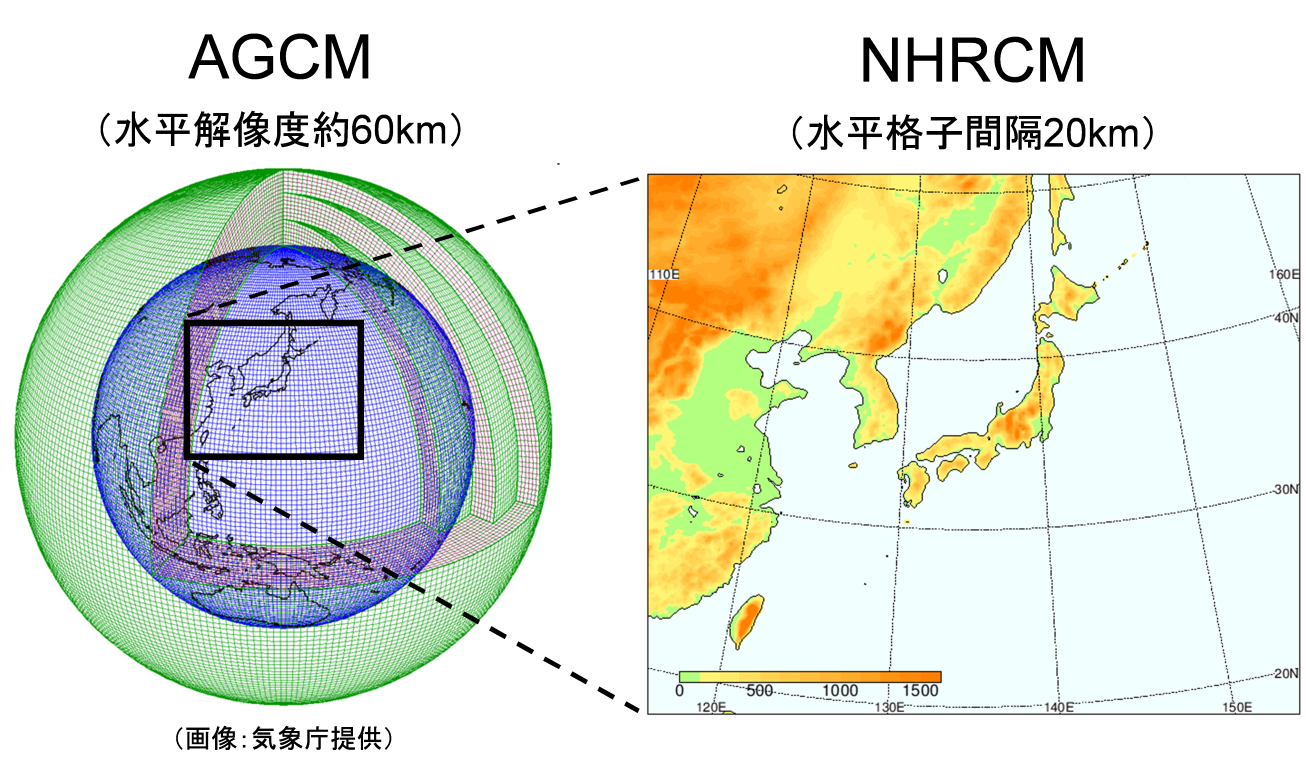Experimental Design of d4PDF
The d4PDF consists of outputs from global warming simulations by a global atmospheric model with horizontal grid spacing of 60 km (hereafter AGCM; Mizuta et al. 2012) and from regional downscaling simulations covering the Japan area by a regional climate model with 20 km grid spacing (hereafter RCM; Sasaki et al. 2011, Murata et al. 2013).

Four sets of experiments are performed by the AGCM;
- historical climate simulation: 1951-2010, 100 members
- non-warming simulation: 1951-2010, 100 members
- +2K future climate simulation: 2031-2090, 54 members
- +4K future climate simulation: 2051-2110, 90 members
The sea-surface temperature (SST), sea-ice concentration (SIC), and sea-ice thickness (SIT) are prescribed as the lower boundary conditions, and global-mean concentrations of greenhouse gases and three-dimensional distributions of ozone and aerosols as the external forcing. Each set of experiments has 54-100 ensemble members, for which the initial conditions and the lower boundary conditions are perturbed.
For the non-warming simulation, the same boundary conditions as the historical simulation are given, except that the long-term trend is removed. This simulation is intended for comparison with the historical simulation for attribution studies of historical climate change.
The future climate in which the global-mean surface air temperature becomes 4 K warmer than the pre-industrial climate is simulated in the +4K simulation. For the use of the +4K simulations, climatological SST warming patterns (ΔSSTs) are added to the observational SST after removing the long-term trend component. Six CMIP5 models were selected, and 15-member ensemble experiments are conducted for each of the six ΔSSTs, giving a total of 90 members. The greenhouse gases are set to the value in 2090 of the RCP8.5 scenario. In this simulation, the amplitude of the warming is kept constant throughout the 60-year integration of the years labeled from "2051" to "2110".
Results of a +2K simulation has been available since August 2018. The same six CMIP5 models were selected as in the +4K simulation, and 9-member ensemble experiments are conducted for each of the six ΔSSTs, giving a total of 54 members.The greenhouse gases are set to the value in 2040 of the RCP8.5 scenario.
The dynamical downscaling simulations by the RCM are conducted from AGCM;
- historical climate simulation: Sep1950-Aug2011, 50 members
- +2K future climate simulation: Sep2030-Aug2091, 54 members
- +4K future climate simulation: Sep2050-Aug2111, 90 members
Using the RCM results are recommended for analyses around the Japan region.

d4PDF User's Manual
For details of the experimental design and usage of the database, please refer to the following documents.
(Manuals will be updated when additional simulations are conducted.)
Details of the experimental design (Link to a published paper from BAMS)
Description of the +2K warming experiment (Link to a published paper from GRL)
The dataset user guide (in English)
Access point for d4PDF data
Data Integration and Analysis System Program (DIAS)
Data Release Policy